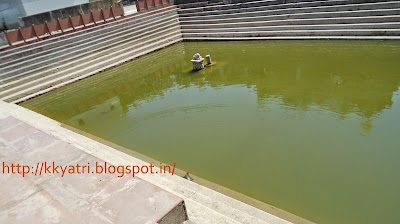Kirti Mandir is built in memory of "Rashtrapita Mahatma Gandhi" whom we popularly know as "Bapu". It is just side by side to his ancestral house where he was born in Porbandar. Infact entrance to the old house is through the courtyard of the Kirti Mandir. So whoever comes here visits both the buildings.
 |
| Entrance of old building where Gandhi ji was born at Porbandar,Gujrat |
 |
| Typical wooden stair at the Birth Place of Mahatma Gandhi at Porbandar, Gujrat |
And the most interesting are the stairs. These are made of wood and are very narrow. Its rise (height of a single step) is too much to be comfortable. So to help climbing these steps there is provided a thick rope hanging from the ceiling to the side of the stair. So hold this rope and pull it when going upstairs, this will reduce pressure on your feet. On both floors rooms of different sizes with small windows are there. The entry from the main gate is to a small courtyard. On the right you will see two staffs on the veranda who will give you some information about the place. Next to this veranda is the very room where Bapu was born. On a wall of this room a board gives information that the place on the floor where a mark of "Swastika" is made is exactly the birth place of Mahatma Gandhi. Just above this mark a big framed photo of Gandhi ji making thread on the 'Charkha' is hanging on the wall. Standing in this room will give you a feeling of reverence towards Bapu. Next to this room is his mothers room. Many other rooms like kitchen and stores are on the left side of it. Information about different rooms are written on the boards in every important room. On the first floor is a small but airy room which was the study room of Bapu in his childhood.
 |
| Study Room of Bapu in his ancestral house where he was born at Porbandar, Gujrat |
 |
| Bapu's Parents, at his birth place, Porbandar, Gujrat |
 |
| Kirti Mandir, Porbandar, Gujrat |
Kirti Mandir is very neat and clean and spacious too. A big courtyard and lot of used marble makes a good impression on visitors mind. Just like a temple you have to put off your shoes at the main gate of the building. Just across the
 |
| A view of the lane on which Kirti Mandir and Bapu's Birth Place is situated. On the right is attractive gate of Kirti Mandir at Porbandar, Gujrat |
 |
| Family Tree of Mahatma Gandhi, on the wall of museum at Kirti Mandir, Porbandar, Gujrat |
 |
| Baa and Bapu's life size pictures in a Mandap at Kirti Mandir, Gujrat |





























